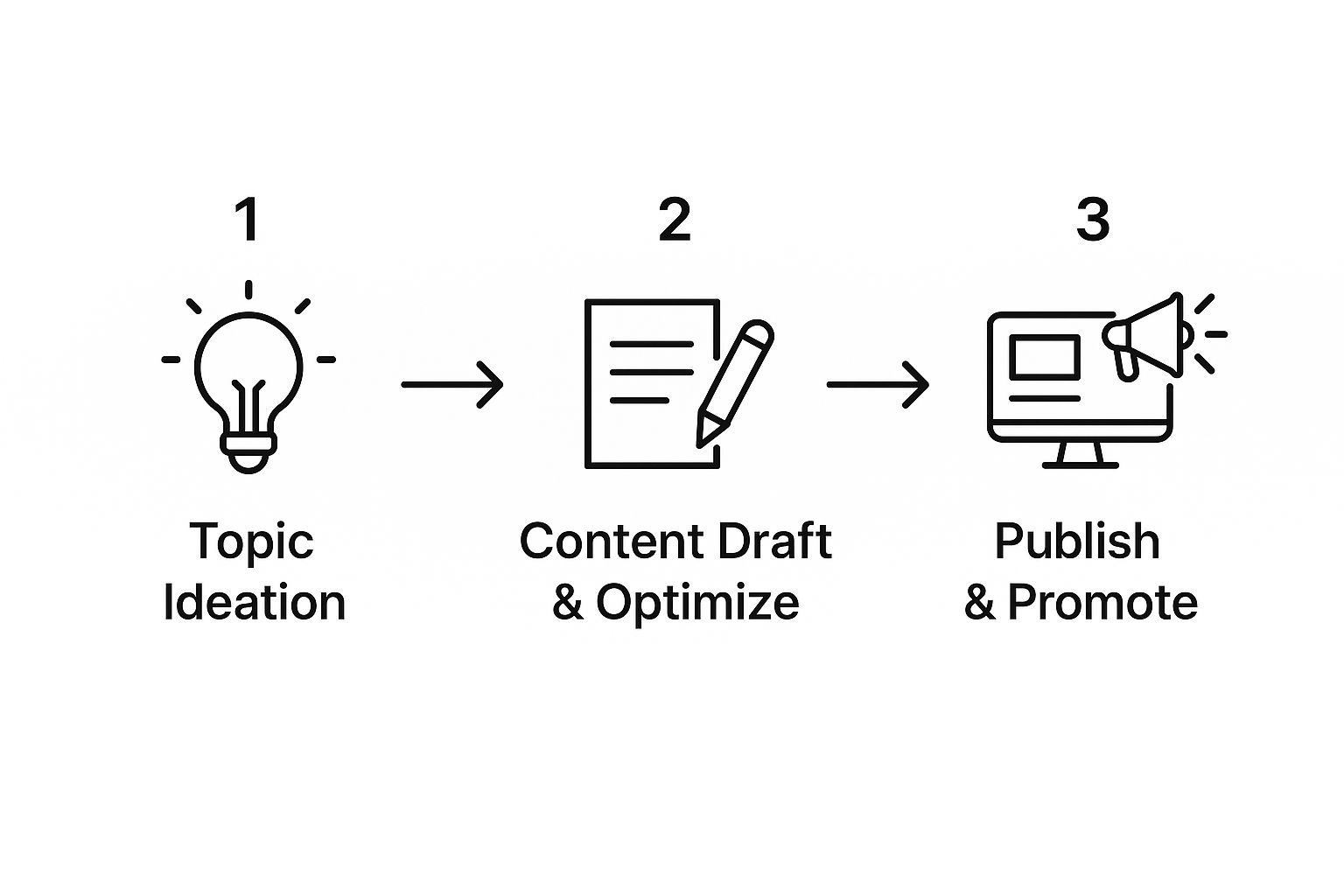If you want to drive more organic traffic, you can't just throw a bunch of random tactics at the wall and see what sticks. You need a system. A reliable framework for growth boils down to nailing three core areas: mastering on-page relevance to meet user intent, ensuring technical flawlessness so search engines can actually find and understand your site, and building off-page authority to prove you’re a credible source.
Get these three pillars right, and you have a clear roadmap to sustainable traffic growth.

Before we jump into the "how-to," let's quickly cover why this channel is worth your time and effort. Unlike paid ads that disappear the moment you stop feeding the machine, organic traffic is an asset that builds on itself. It compounds. Every person who lands on your site from a search engine is there because they're actively looking for an answer you might have, making them incredibly qualified from the get-go.
This isn’t just a gut feeling; the data has been telling this story for years. In 2025, organic search is still the undisputed king, driving roughly 53% of all website traffic across the web. That number completely overshadows every other channel, making it crystal clear that if you want long-term success, you have to get good at search.
People coming from Google or Bing aren't just window shopping. They have a problem to solve or a question that needs an answer, right now. When your content is the one that provides that solution, you build instant trust. It's this high-intent nature that leads to higher engagement, longer time on page, and better conversion rates compared to traffic from social media or display ads.
Here’s another way to think about it: paid traffic is like renting an audience, but organic traffic is like building your own. Every piece of optimized content you publish acts like a digital salesperson, working for you 24/7 to attract and convert your ideal customers. This is how you build a predictable, scalable growth engine. For a much deeper look at building this kind of sustainable traffic, this comprehensive guide on how to improve organic traffic is a great resource.
To systematically grow your organic traffic, you need a plan that goes beyond just chasing keywords. We break the entire process down into three core components. This framework helps you organize your efforts, diagnose problems, and focus on what will actually move the needle. You can find more detailed strategies in our guide on how to increase organic traffic.
Let's break down this foundational model.
This simple table organizes the entire SEO process into three buckets. Every successful strategy we'll cover in this guide fits into one of these pillars. Understanding how they work together is key.
| Pillar | Primary Focus | Key Outcome |
|---|---|---|
| On-Page SEO | Creating relevant, high-quality content that directly answer By focusing your energy on these three areas, you're no longer just guessing. You're building a resilient website that both search engines and, more importantly, your users will love. This is the shift from random acts of SEO to a structured, repeatable system for driving real results. Building Topical Authority for Search Dominance If you're still chasing individual, high-volume keywords, you're playing a game you can't win. That’s an outdated race to the bottom. To see real, sustainable growth in your organic traffic, you have to think bigger. Stop acting like a keyword hunter and start behaving like a genuine subject matter expert. The goal is to build topical authority. This means becoming the go-to resource for an entire subject, not just a handful of search queries. This requires a move away from a scattered, "what should we blog about this week?" approach. Instead, you need to embrace a structured and far more powerful model: the topic cluster. Instead of a bunch of unrelated articles, you create a central "pillar" page on a broad topic and surround it with "cluster" articles that dive deep into specific subtopics. This web of interconnected content sends a crystal-clear signal to search engines that your site knows this subject inside and out. From Keywords to ConversationsThe first change you need to make is in your keyword research. Forget just grabbing terms with the highest search volume. You need to understand the conversation your audience is having. What are their real problems? What questions pop up after they get their first answer? Think of it this way: someone searching "how to improve organic traffic" is just at the beginning of their journey. Soon, they'll have more specific, nuanced questions.
Every single one of these questions is a perfect candidate for a piece of cluster content. Your job is to map out these conversational threads and create content that addresses every stage of the user's journey, from total beginner to seasoned pro. Designing Your Pillar and Cluster StrategyYour pillar page is the strategic heart of your topic cluster. It’s a broad, comprehensive resource that gives a high-level overview of your main topic. Think of it as your "Ultimate Guide" or the central hub for everything related to that subject. A supporting cluster page, on the other hand, is a deep dive into one specific subtopic you touched on in the pillar page. So, if your pillar page is "The Ultimate Guide to Project Management," a cluster article might be "Choosing the Best Project Management Software." Key Insight: The real magic happens when you link these pieces together. Every single cluster page must link back to the main pillar page. This internal linking structure is what forms the "cluster," telling Google that these pages are all related and that your pillar page is the most authoritative resource on the topic. This model doesn't just help search engines understand your site's expertise; it also dramatically improves the user experience by naturally guiding visitors to other relevant, helpful content. For a deeper look at this, check out our detailed article on how to improve your organic search ranking. Putting It All Into PracticeLet’s say you run a small business selling eco-friendly cleaning supplies. Instead of writing random blog posts, you decide to build topical authority around "Sustainable Home Cleaning." Here's how it would look:
With this structure, your blog transforms from a simple collection of posts into a true library of expertise. You’re no longer just fighting for one keyword; you’re aiming to dominate an entire topic. To consistently produce this level of content, it helps to be systematic by optimizing your content creation workflow. This is exactly how smaller businesses can outmaneuver larger competitors and become the definitive source of information in their niche. Fixing the Technical Issues That Kill Your TrafficYou can have the most brilliant content and a perfectly mapped-out topical strategy, but if search engines can't crawl, render, and understand your website, none of it matters. Technical SEO isn't some dark art for developers—it’s the foundation of any plan to grow organic traffic. When that foundation is shaky, every other effort becomes a waste of time. Think of it like building a house. Your content is the beautiful furniture and decor. But if the walls are crumbling, the doors are locked, and the lights don't work, nobody is going to stick around to appreciate it. Search engine crawlers are just as picky. The journey from an idea to getting traffic has a lot of steps, but that middle part—"Publish & Promote"—is where your site's technical health can make or break you.  This shows that hitting "publish" is just the beginning. Making sure your content is technically sound and actually gets indexed is where the real work begins. Prioritize Blazing Fast Site SpeedSite speed stopped being a "nice-to-have" years ago. It’s a core ranking factor and, more importantly, a massive signal for user experience. Google's own data found that if a page takes 3 seconds to load instead of 1, the chance a user will bounce skyrockets by 32%. If your site is slow, you're literally losing visitors before they even get a chance to read a single word. Your first stop should be Google's PageSpeed Insights. Punch in your URL, and it will give you a performance score and a laundry list of fixes based on Core Web Vitals—metrics that gauge real-world user experience on loading, interactivity, and visual stability. The usual suspects behind a slow site are almost always the same: Build a Logical Site ArchitectureA clean, logical site structure is a win-win: it helps users find what they need, and it helps search engines understand your content hierarchy. This is how you spread authority (or "link juice") effectively and show Google what your most important pages are. A flat, simple structure almost always beats a deep, complicated one. I live by the three-click rule: a user should be able to get to any page on your site from the homepage in three clicks or less. This simple guideline forces you to build a structure that’s easy for crawlers to discover and navigate. Pro Tip: Your URLs should reflect your site structure. A clean URL like Master Crawlability and IndexingIt's a simple, brutal truth: if Google can't crawl your pages, they can't be indexed. And if they aren't indexed, they will never rank. Head straight to Google Search Console and open the "Pages" report. This is your command center for crawl issues. It will tell you exactly which URLs are broken, blocked, or otherwise causing problems. Next, you need to think about your crawl budget—the finite number of pages Googlebot will crawl on your site in a given period. For larger sites, this is critical. You can't afford to have Google waste its time on low-value pages like old archives or useless tag pages. If you want to dig deeper, you can learn about mastering crawl budget optimization to make sure every crawl counts. This is where automation becomes a huge advantage. Instead of waiting for Google to eventually find your new content, a tool like IndexPilot can automatically monitor your sitemap and ping search engines like Google and Bing the instant you publish or update a page. This takes the guesswork out of indexing and dramatically shrinks the time it takes to see ranking improvements. Finally, get serious about structured data (schema markup). This is code that you add to your pages to give search engines explicit context about your content. Adding schema for articles, products, or FAQs can help you earn rich snippets in the search results, making your listings stand out and begging to be clicked. Earning Authority with Modern Off-Page SEOGetting your on-page and technical SEO in order is non-negotiable, but it’s really only half the battle. If you want to rank for competitive terms and see a serious lift in organic traffic, you need to build authority. This is the part that happens off your website. Think of it as building a digital reputation. Off-page SEO is all about sending signals to Google that tell them your content is credible, trustworthy, and genuinely valued by others in your field. It's the proof that you don't just say you're an expert—other people think so, too. Moving Beyond Old-School Link BuildingFor years, "off-page SEO" was just another term for link building. And while backlinks are still an incredibly important ranking factor, the game has completely changed. The old-school tactics of spamming blog comments, buying links from shady directories, or using private blog networks (PBNs) are now a one-way ticket to a Google penalty. Modern off-page SEO is about earning links, not just building them. It's a shift toward a quality-over-quantity mindset, driven by relationships and genuine value. A single, relevant backlink from a highly respected industry authority is worth far more than hundreds of low-quality links from random, irrelevant sites. The Modern Mindset: Stop asking, "How can I get a link from that site?" Start asking, "What can I create that's so valuable they'll want to link to it?" This shift in perspective is the secret to a sustainable off-page strategy that actually works. Creating Genuinely Link-Worthy AssetsSo, how do you earn those high-quality links? You create something that other websites need to cite to make their own content better. These are what we call "link-worthy assets," and they are the absolute cornerstone of a modern SEO strategy. Here are a few powerful types of assets you can create: Once you have an asset, the next step is smart, targeted outreach. This isn’t about blasting a generic email to a huge list. It’s about carefully identifying specific websites, journalists, or bloggers whose audience would find your resource genuinely useful and then reaching out with a personalized message. The Power of Unlinked Brand MentionsHere's something a lot of people miss: Google is now smart enough to understand context even without a clickable link. Unlinked brand mentions are becoming a surprisingly significant trust signal. This is when another site mentions your brand, a key person, or a product without linking back. These mentions show Google that your brand is a real entity and part of the conversation in your industry. It validates your authority. While it's always a good idea to reach out and politely ask if they can turn that mention into a link, the mere existence of the mention adds weight to your digital reputation. Digital PR and Industry ConversationsThe final piece of this puzzle is actively engaging in digital public relations (PR). This means getting involved in your industry's community. It takes many forms, all of which boost your off-page presence and ability to improve organic traffic. For more ideas on driving visitors, check out our guide on how to get more website traffic. Consider these highly actionable strategies: By combining the creation of killer link-worthy assets with strategic digital PR, you build a powerful web of authority signals that drives not just rankings, but real, high-quality referral traffic. Getting Ready for What's Next in Search and UX Take a look at today's search results. It’s a world away from the simple blue links of a few years ago, now packed with AI Overviews, interactive answer boxes, and all sorts of rich snippets. This isn't just a cosmetic change; it's a fundamental shift in how people find information. To keep winning at SEO, you have to skate to where the puck is going. A good strategy works today, but a great strategy is already preparing for what search will look like tomorrow. That means adapting to a reality where AI answers questions directly, users expect flawless experiences, and getting a click is harder than ever. This isn't a threat—it's an opportunity. The path from a user's query to your website is becoming more varied, with AI, voice, and visual search creating new entry points. If you can adapt, you can win in ways your competitors haven't even thought of yet. Optimizing for a World with Fewer ClicksOne of the biggest shifts we're seeing is the rise of zero-click searches. This is when a user gets their answer right on the search results page (SERP) without ever needing to click through to a website. It might sound like a traffic killer, but you can actually turn this into a massive branding play. The trick is to own the SERP features that provide these answers. Key Takeaway: Even if you don't get the click, winning a Featured Snippet or PAA box builds enormous authority. Your brand becomes the trusted source for the right answer, and that trust pays off down the road. While the top 5 organic results still snag around 70% of clicks, the game is changing. Some analysts predict AI-driven search could slash organic traffic for some brands by as much as 50% by 2028. This makes owning those high-visibility placements on the SERP more critical than ever. The Unbreakable Link Between Core Web Vitals and RankingsGoogle couldn't be clearer: user experience (UX) is a direct ranking factor. It's not optional. The Core Web Vitals are a set of specific, non-negotiable metrics that measure the real-world experience a user has on your page. These vitals break down into three key areas: Ignoring these is like telling Google you don't mind frustrating your visitors. That's a powerful negative signal that will tank your rankings. A happy user sends one of the strongest signals to Google that your content is valuable. For a deeper dive into boosting your site's visibility, check out our guide on 9 proven strategies to improve website visibility in 2025. A future-proof SEO strategy means embracing this connection between your site's technical health and your user's satisfaction. By anticipating these shifts and always putting the user first, you’re building a resilient traffic engine that can weather any algorithm update Google throws your way. Got Questions? Let's Talk SpecificsEven with the best game plan, SEO always throws a few curveballs. You're not alone if you're wrestling with the nitty-gritty details. Let's tackle some of the most common questions I hear from people trying to move the needle on their organic traffic. Getting these right can be the difference between a good campaign and a great one. Think of this as the "what they don't always tell you" section. How Long Does This SEO Thing Actually Take?This is the million-dollar question, isn't it? The honest, no-fluff answer is: it depends. But I know that's not helpful, so let's get more specific. You should generally start seeing some real, measurable movement in about 3 to 6 months. But that timeline can stretch or shrink based on a few key things: It's like planting a tree. You don't get a shady oak in a week. The first few months are all about building strong roots. The big, traffic-driving growth usually comes after that foundation is set. How Can I Tell a Good Backlink From a Bad One?This is a critical skill. Not all backlinks are good for you—in fact, some can actively hurt your site. A good link is like a solid recommendation from a respected peer; a bad one is like a shout-out from a spammer. The bottom line? A good backlink feels earned and makes sense editorially. A human would click it and find it helpful. A bad one just feels out of place, forced, or paid for. Make it a habit to check your backlink profile every so often and get rid of any toxic junk you find. How Do I Actually Measure the ROI of Organic Traffic?Proving the value of SEO is key to getting buy-in and budget. While it’s not as straightforward as seeing your cost-per-click in a paid ad campaign, it's absolutely doable if you set things up correctly. My Takeaway: Don't just measure sales. The value of organic traffic also comes from leads, brand visibility, and building an audience that you own, free from the whims of ad platforms. First things first: get your goals set up in Google Analytics. Track every important action—form submissions, newsletter sign-ups, demo requests, you name it. If you can assign an average dollar value to each of those conversions, you can start connecting organic traffic directly to revenue. For e-commerce sites, it's even easier since you can track every sale that comes from an organic search. Just don't forget to consider the lifetime value of that customer—organically acquired users often stick around longer. Tired of waiting for Google to find your new content? Take control of your indexing. IndexPilot automates the process by instantly pinging search engines whenever you publish or update a page, ensuring your hard work gets seen faster. Start your free 14-day trial and see the difference. Get automatic sitemap indexingIdentify trends, track key metrics, and make data-driven decisions to optimize your strategies. Copyright © IndexPilot 2025. All rights reserved. | Terms of Service | Privacy Policy |